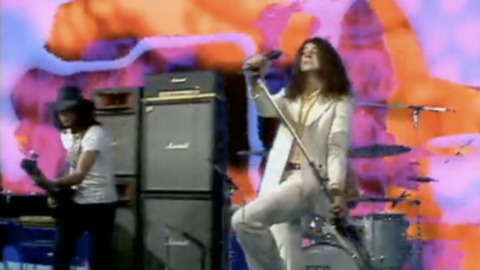Lost and Found: Deep Purple, GeoCities, and the Web as Archive

The Web and cloud computing have made the work of archivists and record keepers faster than ever before, but is information lost in the internet’s labyrinth any more accessible than the physical objects we’ve been misplacing for centuries?
Two years ago a film archivist unearthed an original copy of Fritz Lang’s Metropolis, a version lost to the world for over 80 years. The fully restored film, complete with about 25 minutes of very-rarely-before-seen footage, begins screening in New York this week. The New York Times‘s Larry Rohter nicely sums up the importance of the find:
For fans and scholars of the silent-film era, the search for a copy of the original version of Fritz Lang’s “Metropolis” has become a sort of holy grail. One of the most celebrated movies in cinema history, “Metropolis” had not been viewed at its full length—roughly two and a half hours—since shortly after its premiere in Berlin in 1927…
But the archivist, Fernando Peña, following whispers that a complete print had somehow wound up in Argentina, cut through a wall of red tape to finally gain access to Buenos Aires’s Museo del Cine, where he found the film cans sitting on a shelf. The footage fills out a storyline that has been incomplete for decades, reinserting subplots and scenes deemed too “complicated” at the time.

This morning, reading the story of Peña’s discovery, I thought about how years ago I had been on a search for the original version of another silent Weimar classic—F.W. Murnau’s Nosferatu. Back before I got my first dial-up modem, my obsession with the film led me to dig through the kind of archives that are open to lay-researchers: video stores at the mall, thrift and junk shops, public libraries. The film has a number of intertitles, and in the first VHS copy I got my hands on the German intertitles had been cut out and replaced with English translations, but these intertitles were very clearly a new addition to the film, and they disrupted the atmosphere of the foggy, slightly grainy black and white footage of a vampire in his castle. I wanted to find the original, with the original intertitles, but the back of that VHS copy mentioned something about the estate of Bram Stoker taking issue with the film’s “resemblance” to Stoker’s Dracula, leading a court to order all copies of the film destroyed in the 1920s. Obviously some copies had survived, but I wondered whether the original intertitles had been lost over the years. I picked up a few other VHS copies and later DVDs, but all had different intertitles; when I finally figured out the internet, I ordered Kino’s DVD version, but those intertitles were some of the crispest and newest-looking yet.

In many ways, the internet has made it almost infinitely easier to find the exact cultural document we’re looking for, if we know what we’re looking for. If not, the object of our search might as well be sitting on a shelf in Buenos Aires. In my case, the closest I’ve found to my ideal copy is hosted for free, online, with intertitles that—while not original—are aged enough to fit the overall mood of the film. The same version can also be found on YouTube; another example of the way the internet thrives on copies and instant proliferation. Another: to insert the image of the Nosferatu poster above, I made a copy of an image I found online and uploaded it to my own flickr account, doubling the presence of that image on the Web. The internet also thrives on variety and options: the online archive grow more comprehensive every day. I recently wanted to find a specific video of a specific song that I had seen a few years ago. I searched for Deep Purple’s “Highway Star,” and came up with a few different results. I wasn’t looking for this one, live from ’72—it’s a little too long. I certainly wasn’t looking for this one from some reunion tour. Finally, however, I found the right one. If you watch it, I think you’ll see why I wanted to find this particular version.
But I won’t bet that the next time I go looking for the video I’ll find it in the same place. I hesitate to even put these links in this post, as they’ll probably die their natural internet death before long. As I have discussed before, information on the Web exists with the constant threat of being unpublished. The physical still has that interesting advantage over the digital.
For example, what if you’re looking for something not as well known as a seminal film of the silent era? What if you want to find a Titanic fan site from 1997? When Yahoo shut down GeoCities in October of last year, they made your search that much harder, if not impossible. The pace at which the Web chugs along is so fast that Mashable’s reaction to the news of that move was “GeoCities to Shutdown; What Was GeoCities, You Ask?“

But what people put up on GeoCities was valid cultural expression, the creation of an original aesthetic, complete with hard-to-read font colors and flashing gifs. The Internet Archive has put in an admirable effort to preserve some of the pages on GeoCities, but accessing their directory of saved files is a convoluted and confusing process. Not to say it’s not without it’s rewards: in my search for one of my own GeoCities sites (which I was unable to find), I stumbled upon a Christian rock band photo, a close-up look under the hood of a jeep, a page explaining that a Wormship “is a sort of giant organic ‘battleship’ kind of affair,”and thefatigued men to the right standing around in the dust. And that’s just what the Internet Archive managed to salvage. These are bits of information misplaced in the constant reshuffling of the Web, the dead links and discarded images taken out of context and lost to their original purposes. The archives of the web too often go under and leave little trace. While the complete copy of Metropolis went 80 years without being watched, at least it was there. The library at Alexandria had to be burned to the ground before it was destroyed. GeoCities just turned off.



